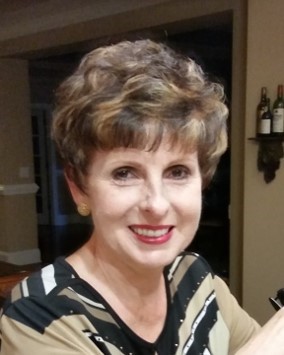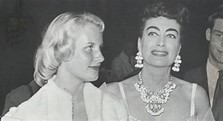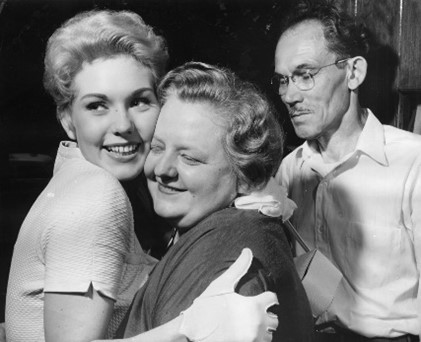Guest Blog: Mothers and Daughters: In Life and On Film

Sharon Walters
Over the course of my life, I can no longer count how many movies I have watched. But I can count the movies that changed my perspective of how life can be lived. The movies that I’m reflecting on have a common thread. They relate to the mother-daughter relationship struggle, and these leading ladies are as complicated as the roles they chose.
How can we forget Joan Crawford as Mildred Pierce (1945) who is obsessed with her oldest daughter and will do anything to keep her in a grander lifestyle that Mildred had never known? Bette Davis as Charlotte in Now, Voyager (1945) as the abused, lonely woman that has been browbeaten into being her mother’s constant companion. And in another unforgettable role Bette Davis as Regina in The Little Foxes (1941) as the cold- blooded, greedy, and ruthless mother convinced she is hiding her devious plans from her innocent daughter Alexandra. Kim Novak as Madge in Picnic (1955), the beautiful yet depressed girl pressured by her mother to marry a successful businessman from the better side of the tracks. Rosalind Russell as Mama Rose in Gypsy (1962), who manipulates her daughters, dragging them from state to state because she needs one to be famous.
These five films focus on women trying to break out of their conventional lives. Mildred Pierce is young, beautiful, and very ambitious. She and her husband Bert have two daughters: Kay, the youngest who is innocent, and Veda, her older sister who is cunning. Veda is aware that her mother will do anything for her. She resents her mother and uses phony emotions to control her.
Joan Crawford lived that life in her own childhood. Her poverty and lack of education started a fire in her and a desire to make a name for herself. She was demanding of herself, climbing those hurdles and looking forward. Mildred Pierce was a character she could relate to as she too worked her way to Hollywood Stardom. Veda as well is a girl who will stop at nothing to get where she wants. In this case Mildred becomes the victim, and Crawford delivers in the role.
Joan Crawford was born as Lucille Fay LeSueur in San Antonio, Texas to Anna Bell Johnson and Thomas LeSueur. Her father abandoned the family when Joan was 10 months old. Her mother then married Henry J. Cassin. Cassin had a theatre and Crawford loved watching the vaudevillian acts on stage as a child, preferring the nickname “Billie” already inventing a new persona for herself. Cassin allegedly began sexually abusing “Billie” when she was eleven years old until the time she was sent to a Catholic girl’s school.
Joan would marry four times in her life. The first three ended in divorce. During those marriages she adopted 4 children. We know now that she suffered from obsessive compulsive disorder and was a strict disciplinarian. In 1971 Crawford wrote “My Way of Life” as part memoir, part self-help tips. The title of the book gives us a glimpse of her personality. The book is a controlled narrative, the dominant force to pursue perfection in how women should behave regarding men, sex and raising children. “I was strict about some things,” she writes, “A pediatrician told me if children took naps until they were twelve, they’d be the healthiest ever. The kids hated that as they grew older.” (Page 80.)
In her memoir, she comes across as a self-proclaimed therapist with all the trimmings of elitism. And sadly, for all her wisdom and advice, her oldest daughter, Christina wrote a hell raising account of life with Joan Crawford, her mother The Quintessential Movie Star.
In 1978 Christina Crawford wrote “Mommie Dearest” as her account of being victimized by a cruel, violent, and unhinged mother. She stated that at age 13 her mother grabbed her by her throat, punched her in the face and slammed her head on the floor.
One can’t help but wonder if in the film Mildred Pierce, the actions of mother and daughter display just a taste of what took place behind closed doors at the Crawford home.
In Bette Davis’s film, The Little Foxes, we witness the behavior of a family in constant battle for power. Regina Hubbard Giddens and her two brothers are pursuing an out-of-state cotton mill entrepreneur to partner with them and open a mill in their town, which will make them millions. Her brothers are investing their inheritance. Regina, bitter and resentful, wanting independent wealth and freedom realizes that the only way to get the money is from Horace her husband, whom she hates. She schemes to get her share of the money by sending their daughter Alexandra to bring back her ailing husband who has been convalescing from heart trouble. Alexandra believes that her mother misses him. When Regina’s plan fails and her husband denies her money, during a heated exchange, Alexandra realizes that her mother hates her father and wishes him dead. The brothers resort to theft and Regina, blackmail. After Horace dies, the deal goes ahead. Alexandra sees the truth about her family and in the end leaves Regina alone and afraid.
We could never imagine Regina’s daughter Alexandra writing a scathing account of her mother’s deeds and just how dangerous her relatives could be in the early 1900s. That would have to wait until 1939 for Lillian Hellman to put pen to paper all the stories she was told by her own relatives. The pen is mightier than the sword depending on who lives last.
In the film Now, Voyager Davis portrays the isolated and downtrodden daughter of a vindictive, controlling mother (played understatedly real by Gladys Cooper, who in real life was known to be very warm and welcoming). Davis as Charlotte is a repressed, emotionally stunted woman. Her life takes on new meaning when she is rescued by caring psychiatrist. It’s not only until she is taken to a clinic that she becomes independent. No longer under the control her mother, her sister-in-law and doctor persuade her to take a cruise where beautiful clothes and new friendships help her to transform into an independent, strong person. Eventually she returns home and confronts her mother. She is no longer repressed and afraid to be her own woman.
Bette Davis was born in Lowell, Massachusetts to Ruth and Harlow Morrell Davis. When she was 10 her father divorced her mother, and her mother was left to raise Bette and younger sister Barbara on her own. Bette was twenty-two when she worked on Broadway. Through the years she had a reputation for being a perfectionist. She expected high standards from her co-stars. In the 1930s and 40s she was one of the most celebrated leading ladies. People called her indominable. In many later interviews she stated that she felt she was not intimidating and didn’t quite know why she had that reputation.
Bette was married four times. When she married William Grant Sherry, they had daughter Barbara (BD). Then while married to Gary Merrill, they adopted a girl, who was disabled, and named her Margo and a boy they named Michael. Bette loved being home when she wasn’t working and loved to have company and cook for people. Bette adored all her children but said that BD was her favorite traveling companion and she loved being with her. Bette said in an interview that BD was the love of her life and her children were a blessing.
Two different movies: Now, Voyager and The Little Foxes. In one Davis is diabolical, thinking her daughter will never know the extent of her corruption and in the other she is a depressed woman dominated by her vindictive mother.
Does art imitate life? I think it can. Bette Davis played characters that made choices–characters that did not make peace with their daughters. Even works of fiction can have a ring of truth. as we look at the universal relationships that shape our own lives. At the height of her career, could Bette Davis ever envision her best friend and daughter BD would write a tell-all book in the older years of her life?
BD wrote the 1985 book “My Mother’s Keeper.” In it she depicts her relationship with Bette as troublesome and paints her mother as an overbearing alcoholic. She stated that through all her mother’s failed marriages Bette would always say “no one could take BD away, basically meaning she owned her.” And as she grew older, Bette became more possessive and began to consider BD’s future husband a threat and would verbally abuse her grandchildren. The question is what happened to this seemingly loving relationship?
In the epilogue BD writes an open letter to her mother. BD says: So here it is, Mother, the story of you and me, not as you would have it but as it really was. You have played many roles during my life, some of them brilliantly, some of them basely, but you were only willing to be yourself for a couple of years some fifteen years ago.
In 1987 Bette Davis with Michael Herskowitz published her book “This & That.” In response to BD’s letter, Bette wrote: Dear Hyman, you ended your book with a letter to me. I have decided to do the same. P.S., I hope someday I will understand the title “My Mother’s Keeper.” If it refers to money, if my memory serves me right, I’ve been your keeper all these many years. I am continuing to do so, as my name has made your book about me a success.
Great Hollywood actresses Joan Crawford and Bette Davis had contrasting personalities. Crawford’s words always seemed measured. She always looked straight into the eyes of her interviewer while never letting down her guard—always polished, beautiful, and reserved. In her older years she seemed much more comfortable with interviews.
Davis could be downright funny about her own life, her beauty and work. As she got older, she shared her medical issues helping to empower women that may have felt isolated. She also spoke about the tell all book her daughter BD wrote. As hard as it might have been for her, she shared her personal pain.
Kim Novak by contrast remains soft spoken and introspective. In interviews she never appears to be scripted or angry. She graciously shared her truth about growing up around mental illness and her own life and struggles in and out of Hollywood. She remains to this day an icon and is still adored by her fans.
In the movie Picnic, Picnic is a day in the life of a small-town movie. Novak’s character Madge wants to be loved, but not for just being pretty. Her mother wants Madge to marry Alan, the rich young man in town. The family is poor; if Madge marries up this could elevate the family. The mother goes so far as asking questions about if Madge and Alan kiss, coyly suggesting that she should show him more affection. The mother is a sad character seeking a better opportunity for herself though her daughter Madge. Yet, the mother crosses the sexual boundary of her daughter, prodding her to please a man sexually.
Younger sister Millie, played by Susan Strasberg is an intellectual and not comfortable with her looks. She feels special when Hal, a drifter who comes to town, shows her attention. When she sees the attraction Hal has for Madge is crushed.
Hal asks Madge to meet him in Tulsa, and Millie helps her to think for herself. As Madge prepares to leave her hometown against her mother’s pleading, she pulls away from the tight grasp of her distraught mother. The mother represents how women were demanded to act according to society. That scene has deep underlying tones, saying to its audience that collectively (we) despite fear, might be able to pull ourselves away from family expectations as Madge pulled away at all costs, to save herself and pursue the life she wants versus the one she’s expected to lead.

Christina and Joan Crawford 
BD and Bette Davis 
Kim Novak and her parents 
Rosalind Russell with her mother 
Natalie Wood with her mother
Kim Novak was born in Chicago, Illinois as Marilyn Pauline Novak. She was brought up by a mother who was a strict, serious-minded woman and a father who was tough and struggled with mental illness. Kim describes herself as a shy girl who hid behind the curtains when her parents had company. Growing up in a rough neighborhood, her mother didn’t want her to leave home and was strict about what boys she could go out with. In school Kim won two scholarships to the Art Institution of Chicago and during a semester break while in junior college, she joined friends and traveled cross-country on a tour modeling at refrigerator trade shows. She was discovered by an agent, and she began a long-term contract with Columbia Pictures.
Novak has shared that as a young teen, she was assaulted after being pushed in the back of a parked car that she was walking past. When being interviewed by Robert Osborne at the 2014 TCM Film Festival about the movie Picnic, Novak said that after the movie came out, Joshua Logan wrote about Picnic noting that Kim played the part perfectly as if she were wearing a “Crown of Thorns.” Kim noted that his written words were exactly how she made that character come to life on the screen.
In the musical Gypsy, Rosalind Russell plays the larger-than-life Mama Rose Hovick from the 1957 autobiography “Gypsy: A Memoir” by Gypsy Rose Lee. Natalie Wood plays daughter Louise, who performs as back up to her multi-talented sister (Baby) June. Mama Rose is charming, ambitious and determined. She is banking on June to become and remain a top-billed performer. The relationship between mother and two daughters is strained as they are afraid to quit and go out on their own.
Years pass and the troupe is ready to move on. June runs away and marries leaving Louise to be the center of her mother’s drive for success. Deciding that a burlesque house will be where the performing dream ends, Rose asks Louise to perform on stage just once. She reluctantly does and Louise finds her career. Mama Rose continues to suffocate Louise, a blowout fight ensues, and Louise tells her mother she’s wants her out of her life. Russell gives a standing ovation performance as Mama Rose, a woman that must learn to let go of her adult children.
Rosalind Russell was born one of seven children to Catherine Rosalind Russell to Clara A. McKnight and James E. Russell in Waterbury, Connecticut. The family was well taken care of, and she had a relatively happy childhood. She was one of the rare people who seemed to have little strife in her daughter-mother relationship.
Although she knew her mother wanted her to be a teacher, Russell enrolled in an acting course in college. In vintage interviews I have watched about her, the consensus is the same, she was serious about her work as an actress yet had a great sense of humor. She was loyal to her friends and family. Russell met her husband Frederic Brisson through her good friend Cary Grant and had one son, Carl Lance. In 2014 at the TCM Festival Lance paid tribute to his mother as a woman that wanted to play independent characters was a generous person. In 1973, she received the Jean Herscholt Humanitarian Award for her extensive charity work in Los Angeles and beyond.
Natalie Wood was born Natalia Nikolaevna Zacharenko to Maria Zudlov and Nikolai Zakharenk in San Francisco, California. The family name was changed to Gruden. Eventually Maria moved the family to Los Angeles where the Grudens were far from wealthy. Maria Gruden had her own unfulfilled dream of being a theatre company ballerina. Maria, with her hopes pinned on her young daughter, was banking on fame to turn the family fortunes.
As in the musical Gypsy, Natalie Wood understood that it was up her to perform, smile and make good for her family as an entertainer. Mama Rose in the film was equal in dominance to her own mother. As Natalie grew older and had her own team of agents, Maria Gruden was unrelenting and constantly micromanaging her. Wood started to rebel and insisted on trying out for a role in the film role that would launch her transition to young adulthood in movies.
Later in life after Wood suffered from drug and alcohol abuse and spent years in Freudian Analysis, which she was comfortable sharing if an interviewer asked her. Wood loved and protected her daughter’s and credited her mother for her success.
Why do I love these movies? Because of these Hollywood actresses. They had guts. We may not have lived these stories, but we can certainly relate. The roles they played help us to break out of mediocrity and believe that we can empower ourselves. We understand their personal turmoil and realize that there is hope for the future.
Has time been fair to Crawford? She was famous in a time when it was considered sacrilege to show any form of emotional illness. Where could she have gone for help at that time and still been able to have a career?
Where Crawford was guarded in interviews, Davis was relatable. She made her appearances look easy. She could laugh at herself and tell witty stories of Hollywood. She stayed relevant.
Supposedly a year before her death, Crawford knew that Christina, had written her tell-all book and said that Christina did it for the money—and if her intent was to hurt her, that she was hurt. The book was published a year after her death.
In Bette’s case, she lived to read the book her daughter wrote about her and respond. In her late seventies she would still appear on talk shows and a Barbara Walters special where she talked openly about BD’s tell-all book about their troubled relationship but to also promote her new book in response and to defend herself.
Natalie Wood, Kim Novak, Rosalind Russell, Joan Crawford and Bette Davis are among the best of their generation. They were daughters and mothers—in life and on films. The impressions they made are indelible. I am grateful to them all.
